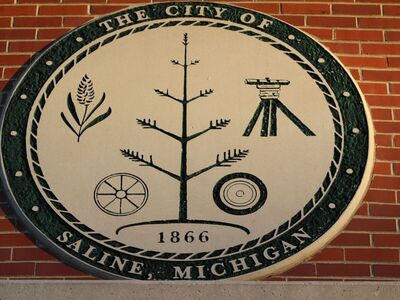Electric Transportation Brought Shoppers to Downtown Saline in Early 1900s
On Feb. 20, 1899, the Village of Saline awarded a franchise to developers for an interurban connecting Saline to Ypsilanti.
The franchise included Chicago (Michigan Ave.) and Adrian (Saline-Milan Road). Also in the package: Henry, Ann Arbor, and Monroe Streets.
The developers did not waste any time. The tracks were laid and the interurban was operating by Sept. 2 that same year.
The tracks followed the south side of Michigan Ave. Investors bought stock in the venture, expecting to become extremely wealthy by laying tracks all the way to Chicago along the dirt highway.
At the time this photo was taken, the line was owned and operated by the Detroit, Ypsilanti, Ann Arbor and Jackson Railway.
One of their challenges was to deliver power to the electric car. All the interurbans ran on 600v DC. The problem with DC was that the voltage dropped the further the car traveled from the power house. The railway had to build a substation every 15 miles to convert the electricity to direct current and provide sufficient energy.
In about 1900, the interurban running to Saline, nicknamed “Old Maud,” stopped in front of the waiting room on the south side of Michigan Avenue a few shops west of Ann Arbor Street. The waiting room sign said ”Detroit, Ypsilanti, Ann Arbor and Jackson Railway.”
Today that waiting room features a stairway inside Mac’s Seafood.
This photo of downtown Saline shows the interurban in its heyday. Note the horses and carriages parked on both sides of the road. Electric transportation was popular because it was cheaper and easier than feeding and caring for a horse.
Things changed drastically when affordable gasoline-powered cars took to the streets.
By 1925, the interurbans and streetcars had lost their attraction. Everybody wanted a gasoline-powered car.
Saline businesses were in favor of cutting off the interurban service in 1925. However, when “Old Maud” disappeared in September 1925, shop owners were sorry, as shoppers and potential business contacts went elsewhere.
The rail service had to stop anyway, because the State of Michigan decided to widen Michigan Ave. The electric railroad could not afford to lay down new tracks.
The end of rail service in Saline was the beginning of a trend throughout the state as the public favored their individual gasoline cars over electric interurbans.
Thanks to the Saline Area Historical Society; thanks also to Dr. H. Mark Hildebradt.
Martha Churchill is a local historian. She can be reached atmc@marthachurchill.com.
More News from Saline
- School Aged Kids Invited to Perform in Broadway Cabaret The Saline Area Players invites school-aged kids to perform a Broadway Cabaret at The Well Church April 17-19.
- GIRLS BASKETBALL: Saline Streaks to 4th Straight Win Many Hornets contributed in Saline's 51-24 win over Novi Friday at Saline High School.














